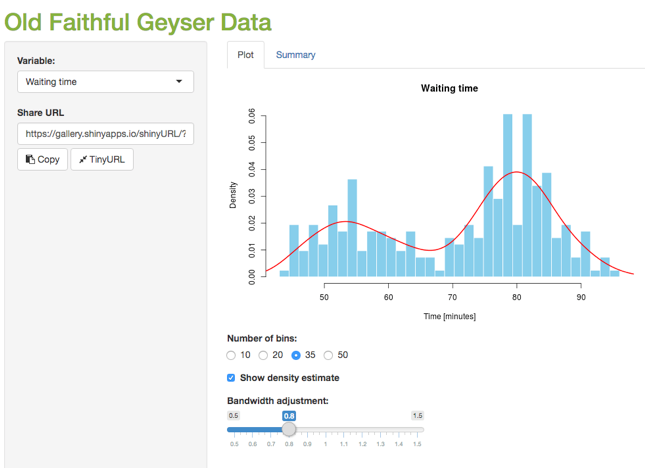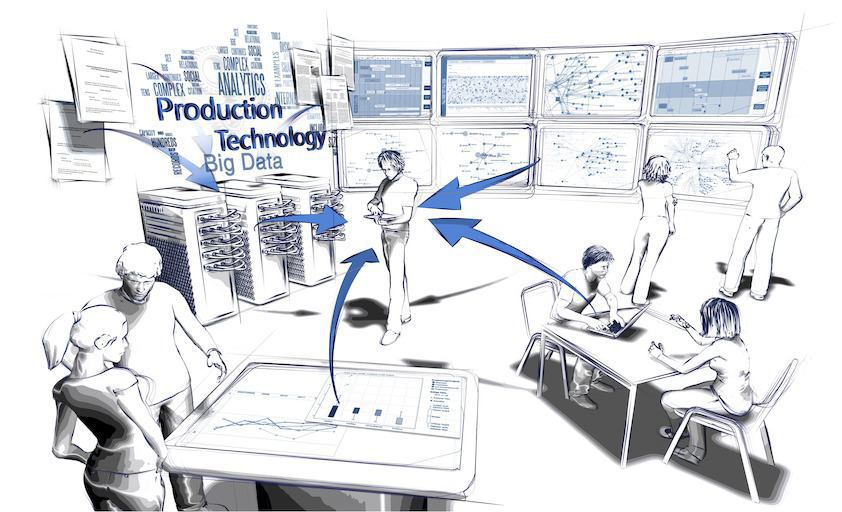Against the background of a digitalizing industry (industry 4.0) the question of how companies and future staff are prepared for these changes is becoming increasingly important. That is why the focus of this empirical-experimental study was put on the investigation of the choice of job of Millennials and their requirements on the ideal workplace. The perspective of high potentials within the group of Millennials was collected by means of two focus groups (n=8) which were carried out prior to the main study, a quantitative conjoint study (n = 165). By applying conjoint analysis, the study empirically investigated the relationship between the attributes job tasks, flexibility, family-friendliness, and salary.
Anne Kathrin Schaar, André Calero Valdez, Tatjana Hamann, Martina Ziefle
In: International Conference on Competitive Manufacturing,
2019
With digitization of production technology changes in technology infrastructure will become more frequent and more important for the competitiveness of organizations. Here, a crucial factor lies in the acceptance of such novel technology by users. Technology acceptance models aim to predict the adoption of new technology in an organization. They are however static in nature and fail to capture to dynamic process of adoption. To overcome this limitation, we utilize quantitative data from a small organization to understand both acceptance patterns and social structure of the organization. Both are used in an agent-based simulation to predict acceptance integrating social effects of diffusion over time. Our simulation achieves very similar results as the quantitative real-world data.
André Calero Valdez, Martina Ziefle
In: International Conference on Competitive Manufacturing,
2019
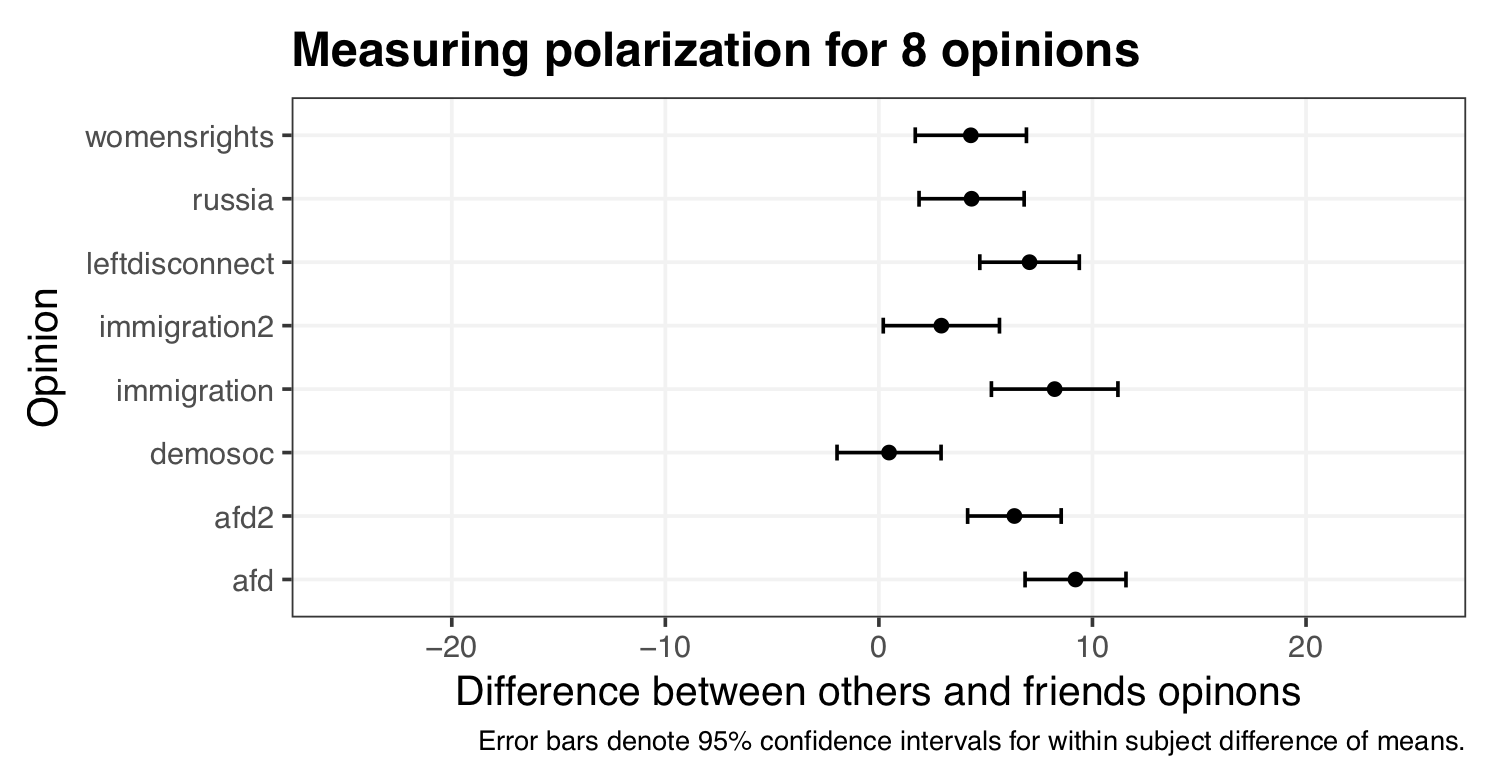
Democracies in the late 2010s are threatened by political movements from the borders of the political spectrum. Right-wing populist parties increasingly find agreement in larger parts of the population. How are these people convinced to these political beliefs? One explanation can be seen in polarization and the phenomena that arise from it such as the spiral of silence. In this article we empirically investigate how digital media usage influences the perception of polarization in Germany using a survey with 179 respondents. We use polarized opinions and mea- sure agreement from two perspectives with them. We find an influence of social media usage on the perception of polarization in our sample. Further, polarization seems to be perceived differently depending on the topic. The results contribute to an understanding of how to adequately design presentation of sensitive or controversial topics in digital social media and could be utilized in student eduction to sensitize social media users to the effect of polarization of opinions.
André Calero Valdez, Laura Burbach, Martina Ziefle
In: European Symposium Series on Societal Challenges in Computational Social Science,
2018
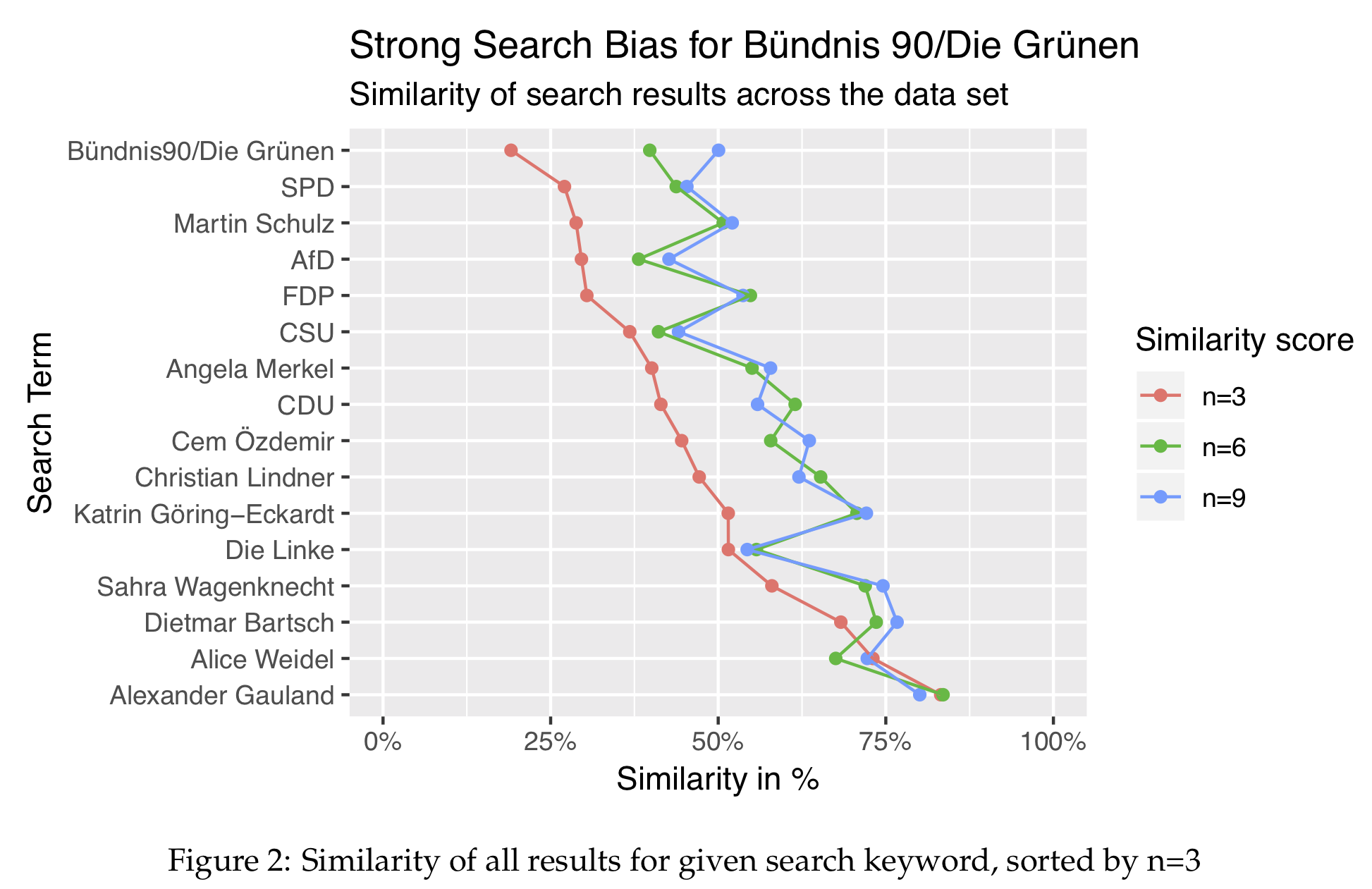
The filter bubble theory, popularized by Eli Pariser in 2011 is subject of academic discussion. With political polarization seemingly increasing, this issue increases in relevance. As recommender algorithms in news-related data bases or search engines such as Google are often intransparent, the project Datenspende: BTW17 aimed at providing data from the users point of view. Google search results for the major German political parties and their leaders of over 1000 participants were collected in order to make sophisticated analyses possible. Based on the data provided, we conducted exploratory tests to investigate how search results of different users differed. As we deemed the order of the search results relevant as well, we compared how the first three, six and nine results were different respectively. We found that differences were the strongest for the first three results, with large differences between the search terms as well, indicating that for some queries filter bubbles could exist.
Johannes Nakayama, Nils Plettenberg, Laura Burbach, André Calero Valdez
In: European Symposium Series on Societal Challenges in Computational Social Science,
2018
Research on spatio-temporal visualization is driven by the develop- ment of novel visualization and data aggregation techniques. Yet, only little research is conducted on the systematic evaluation of such visualizations. Evaluation of such technology is often conducted in real-life settings and thus lacks fundamental requirements for laboratory-based replication. Replication requires other researchers to independently conduct their own experiments to verify your re- sults. In this position paper, we discuss the requirements for repli- cation studies of spatio-temporal visualization systems. These re- quirements are often impossible to achieve for highly contextual visualizations such as spatio-temporal visualizations. We argue that reproducibility—allowing other researchers to validate your findings from your data—is a better aim for highly contextual visualiza- tions. We provide a sample workflow to ensure reproducibility for spatio-temporal visualization and discuss its implications.
André Calero Valdez, Anne Kathrin Schaar, Julian Romeo Hildebrandt, Martina Ziefle
Beliv Workshop 2018 held at IEEE VIS 2018,
2018
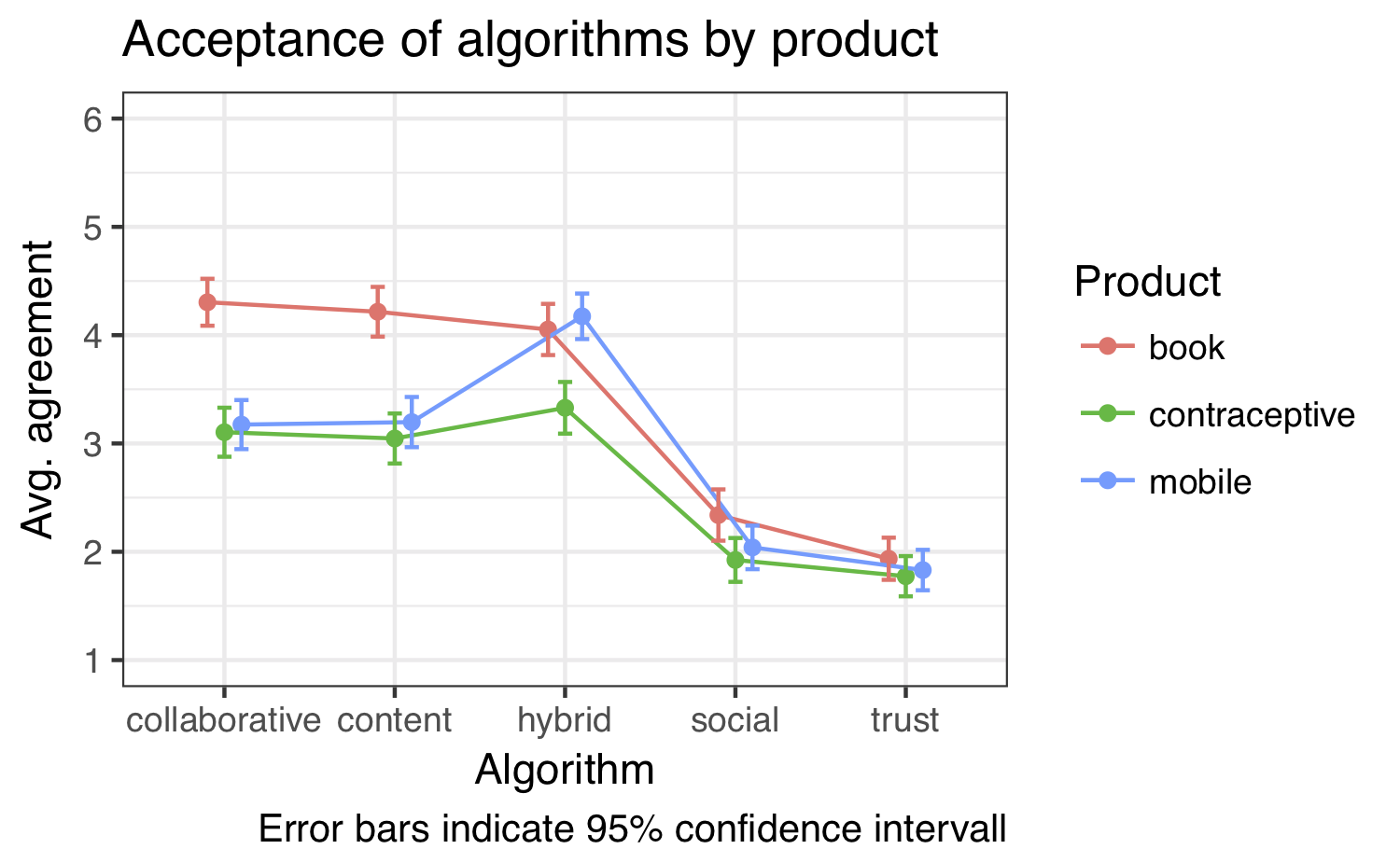
The use of recommendation systems is widespread in online com- merce. Depending on the algorithm that is used in the recommender system diferent types of data are recorded from user interactions. Typically, better recommendations are achieved when more detailed data about the user and product is available. However, users are often unaware of what data is stored and how it is used in recommendation. In a survey study with 197 participants we introduced diferent recommendation techniques (collaborative filtering, content-based recommendation, trust-based and social recommendation) to the users and asked participants to rate what type of algorithm should be used for what type of product category (books, mobile phones, contraceptives). We found diferent patterns of preferences for diferent product categories. The more sensitive the product the higher the preference for content-based iltering approaches that could work without storing personal data. Trust- based and social approaches utilizing data from social media were generally rejected.
Laura Burbach, Johannes Nakayama, Nils Plettenberg, Martina Ziefle, André Calero Valdez
In: Proceedings of the 12th ACM Conference on Recommender Systems, pp. 306–310,
2018
When social media becomes a dominant channel for the distribution of news, manipulation of the news agenda and news content can be achieved by anyone who is hosting a website with access to social media APIs. Falsehoods masked as legitimate news with the intent to manipulate the public are called Fake News. This type of propaganda is disseminated by sharing of individual social media users. Fake news pose a threat to democracies as they influence the public agenda and contribute to polarization of opinions. To limit the dissemination of fake news, social media websites utilize fact-checking badges to flag possibly fabricated content. It has however not been investigated whether these badges are effective and who responds to them. In a survey study with 120 participants we found little evidence for the effectiveness of such badges. However, believability of news in a social media sites were generally rated rather low.
André Calero Valdez, Martina Ziefle
IEA 2018: Proceedings of the 20th Congress of the International Ergonomics Association (IEA 2018) pp 469-477,
2018

Democracies in the late 2010s are threatened by political movements from the borders of the political spectrum. Right-wing populist parties increasingly find agreement in larger parts of the population. How are these people convinced to these political beliefs? One explanation can be seen in polarization and the phenomena that arise from it such as the spiral of silence. In this article we empirically investigate how digital media usage influences the perception of polarization in Germany using a survey with 179 respondents. We use polarized opinions and mea- sure agreement from two perspectives with them. We find an influence of social media usage on the perception of polarization in our sample. Further, polarization seems to be perceived differently depending on the topic. The results contribute to an understanding of how to adequately design presentation of sensitive or controversial topics in digital social media and could be utilized in student eduction to sensitize social media users to the effect of polarization of opinions.
André Calero Valdez, Laura Burbach, Martina Ziefle
In: International Conference on Social Computing and Social Media, pp. 189–202,
2018
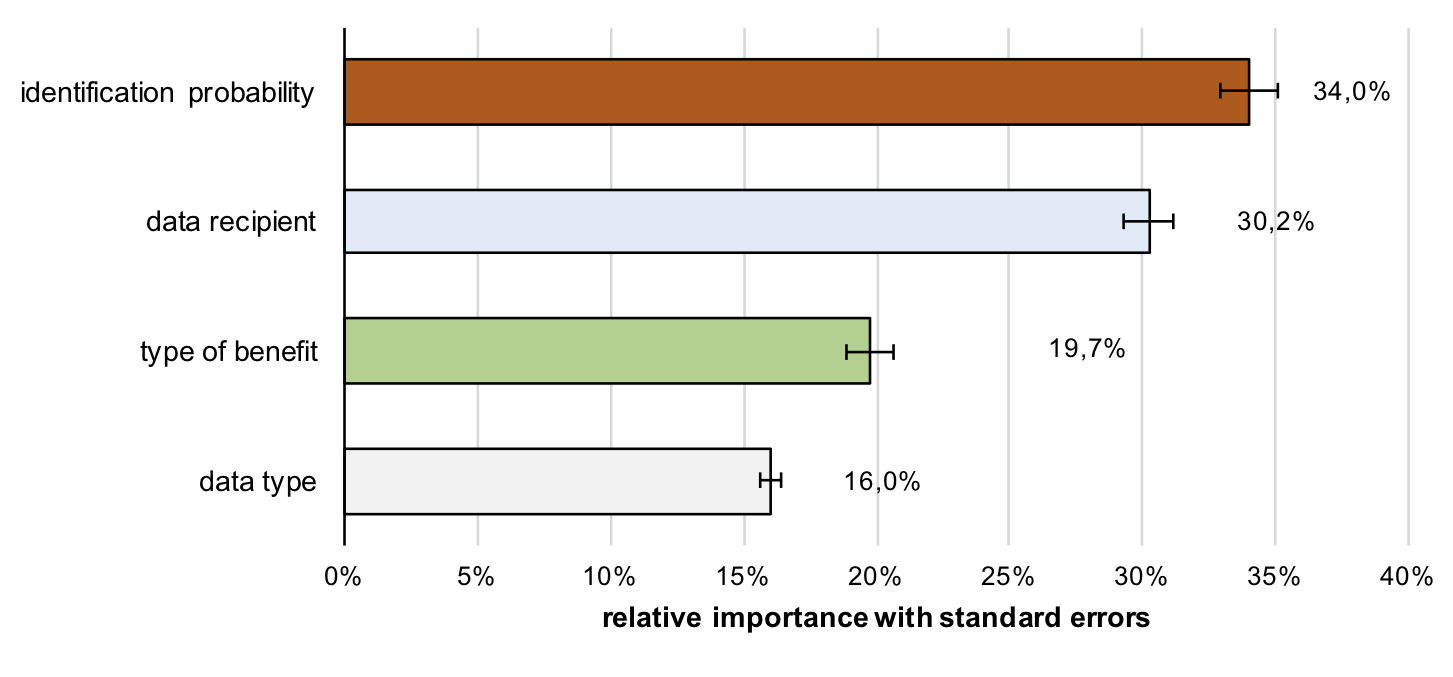
Privacy is a major good for users of personalized services such as recommender systems. When applied to the field of health informatics, privacy concerns of users may be amplified, but the possible utility of such services is also high. Despite availability of technologies such as k-anonymity, differential privacy, privacy-aware recommendation, and personalized privacy trade-offs, little re- search has been conducted on the users’ willingness to share health data for usage in such systems. In two conjoint-decision studies (sample size n = 521), we investigate importance and utility of privacy-preserving techniques related to sharing of personal health data for k-anonymity and differential privacy. Users were asked to pick a preferred sharing scenario depending on the recipient of the data, the benefit of sharing data, the type of data, and the parameterized privacy. Users disagreed with sharing data for commercial purposes regarding mental illnesses and with high de-anonymization risks but showed little concern when data is used for scientific purposes and is related to physical illnesses. Suggestions for health recommender system development are derived from the findings.
André Calero Valdez, Martina Ziefle
In: International Journal of Human-Computer Studies,
2018
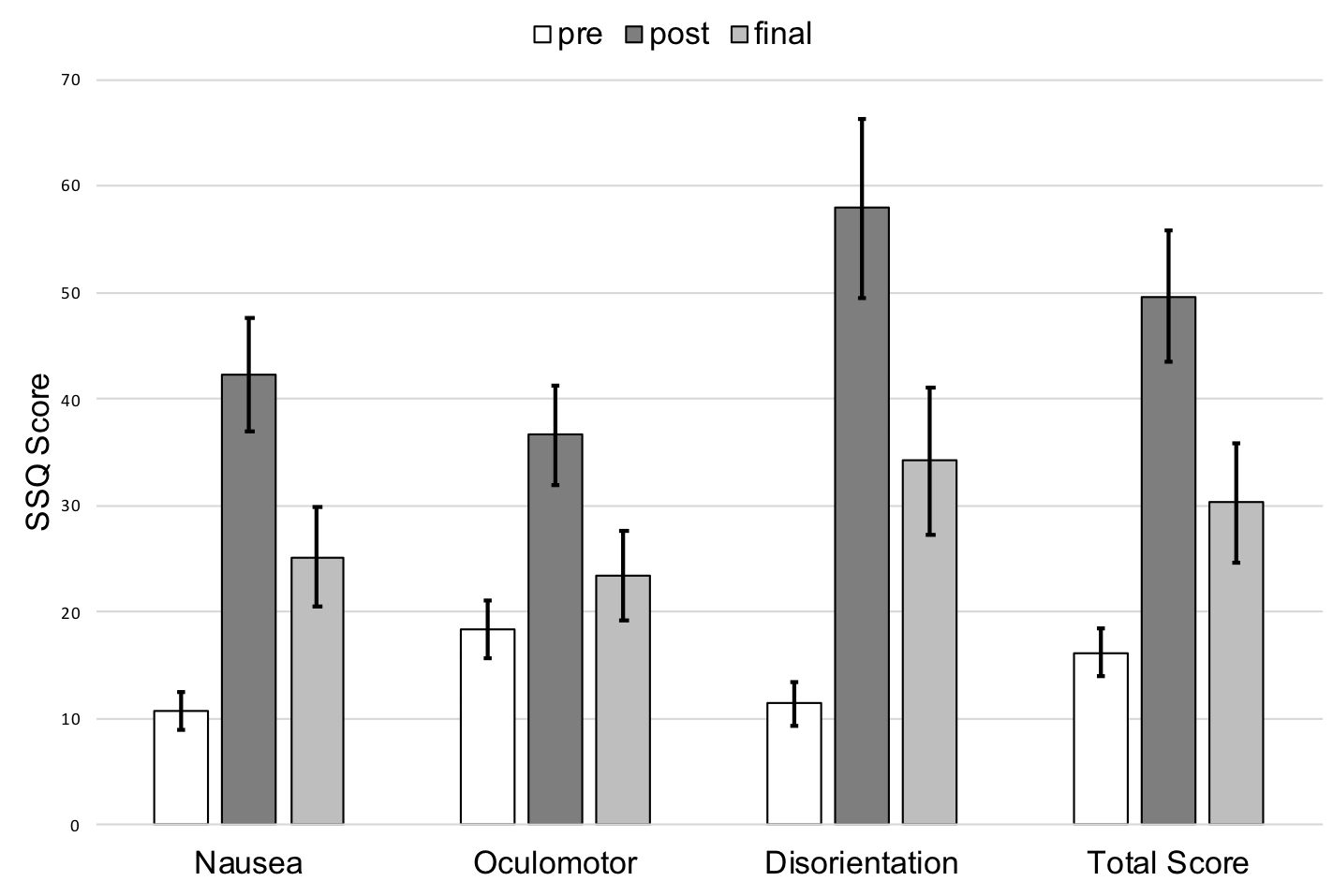
Cybersickness poses a crucial threat to applications in the domain of Virtual Reality. Yet, its predictors are insufficiently explored when redirection techniques are applied. Those techniques let users explore large virtual spaces by natural walking in a smaller tracked space. This is achieved by unnoticeably manipulating the user’s virtual walking trajectory. Unfortunately, this also makes the application more prone to cause Cybersickness. We conducted a user study with a semi-structured interview to get quantitative and qualitative insights into this domain. Results show that Cybersickness arises, but also eases ten minutes after the exposure. Quantitative results indicate that a tolerance towards Cybersickness might be related to self-efficacy constructs and therefore learnable or trainable, while qualitative results indicate that users’ endurance of Cybersickness is dependent on symptom factors such as intensity and duration, as well as factors of usage context and motivation. The role of Cybersickness in Virtual Reality environments is discussed in terms of the applicability of redirected walking techniques.
Julian Hildebrandt, Patric Schmitz, André Calero Valdez, Leif Kobbelt, Martina Ziefle
In: International Conference on Virtual, Augmented and Mixed Reality, pp. 82–101,
2018
We investigate priming and anchoring effects on perceptual tasks in visualization. Priming or anchoring effects depict the phenomena that a stimulus might influence subsequent human judgments on a perceptual level, or on a cognitive level by providing a frame of reference. Using visual class separability in scatterplots as an example task, we performed a set of five studies to investigate the potential existence of priming and anchoring effects. Our findings show that—under certain circumstances—such effects indeed exist. In other words, humans judge class separability of the same scatterplot differently depending on the scatterplot(s) they have seen before. These findings inform future work on better understanding and more accurately modeling human perception of visual patterns.
André Calero Valdez, Martina Ziefle, Michael Sedlmair
In: IEEE Transactions on Visualization & Computer Graphics, 1, pp. 584–594,
2018

In virtual environments, the space that can be explored by real walking is limited by the size of the tracked area. To enable unimpeded walking through large virtual spaces in small real-world surroundings, redirection techniques are used. These unnoticeably manipulate the user’s virtual walking trajectory. It is important to know how strongly such techniques can be applied without the user noticing the manipulation - or getting cybersick. Previously, this was estimated by measuring a detection threshold (DT) in highly-controlled psychophysical studies, which experimentally isolate the effect but do not aim for perceived immersion in the context of VR applications. While these studies suggest that only relatively low degrees of manipulation are tolerable, we claim that, besides establishing detection thresholds, it is important to know when the user’s immersion breaks. We hypothesize that the degree of unnoticed manipulation is significantly different from the detection threshold when the user is immersed in a task. We conducted three studies: a) to devise an experimental paradigm to measure the threshold of limited immersion (TLI), b) to measure the TLI for slowly decreasing and increasing rotation gains, and c) to establish a baseline of cybersickness for our experimental setup. For rotation gains greater than 1.0, we found that immersion breaks quite late after the gain is detectable. However, for gains lesser than 1.0, some users reported a break of immersion even before established detection thresholds were reached. Apparently, the developed metric measures an additional quality of user experience. This article contributes to the development of effective spatial compression methods by utilizing the break of immersion as a benchmark for redirection techniques.
Patric Schmitz, Julian Hildebrandt, André Calero Valdez, Leif Kobbelt, Martina Ziefle
In: IEEE Transactions on Visualization and Computer Graphics, (24), 4, pp. 1623–1632,
2018
In this position paper, we propose and discuss a lightweight frame- work to help organize research questions that arise around biases in visualization and visual analysis. We contrast our framework against cognitive bias codex by Buster Benson. The framework is inspired by Norman’s Human Action Cycle [23] and classifies biases into three levels: perceptual biases, action biases, and social biases. For each of the levels of cognitive processing, we discuss examples of biases from the cognitive science literature, and speculate how they might also be important to the area of visualization. In addition, we put forward a methodological discussion on how biases might be studied on all three levels, and which pitfalls and threats to validity exist. We hope that the framework will help spark new ideas and discussions on how to proceed studying the important topic of biases in visualization.
André Calero Valdez, Martina Ziefle, Michael Sedlmair
In: DECISIVe 2017,
2017
How can you discover something new, that matches your interest? Recommender Systems have been studied since the 90ies. Their benefit comes from guiding a user through the density of the information jungle to useful knowledge clearings. Early research on recommender systems focuses on al- gorithms and their evaluation to improve recommendation accuracy using F-measures and other methodologies from signal-detection theory. Present research includes other aspects such as human factors that affect the user experience and interactive visualization techniques to support transparency of results and user control. In this paper, we analyze all publications on recommender systems from the scopus database, and particularly also papers with such an HCI focus. Based on an analysis of these papers, future topics for recommender systems research are identified, which include more advanced support for user control, adaptive interfaces, affective computing and applications in high risk domains.
André Calero Valdez, Martina Ziefle, Katrien Verbert
In: Proceedings of the 10th ACM Conference on Recommender Systems, pp. 123–126,
2016
Recommender systems are a classical example for machine learning applications, however, they have not yet been used extensively in health informatics and medical scenarios. We argue that this is due to the specifics of benchmarking criteria in medical scenarios and the multitude of drastically differing end-user groups and the enormous context-complexity of the medical domain. Here both risk perceptions towards data security and privacy as well as trust in safe technical systems play a central and specific role, particularly in the clinical context. These aspects dominate acceptance of such systems. By using a Doctor-in-the-Loop approach some of these difficulties could be mitigated by combining both human expertise with computer efficiency. We provide a three-part research framework to access health recommender systems, suggesting to incorporate domain understanding, evaluation and specific methodology into the development process.
André Calero Valdez, Martina Ziefle, Katrien Verbert, Alexander Felfernig, Andreas Holzinger
In: Machine Learning for Health Informatics, Springer, Cham, pp. 391–414,
2016

